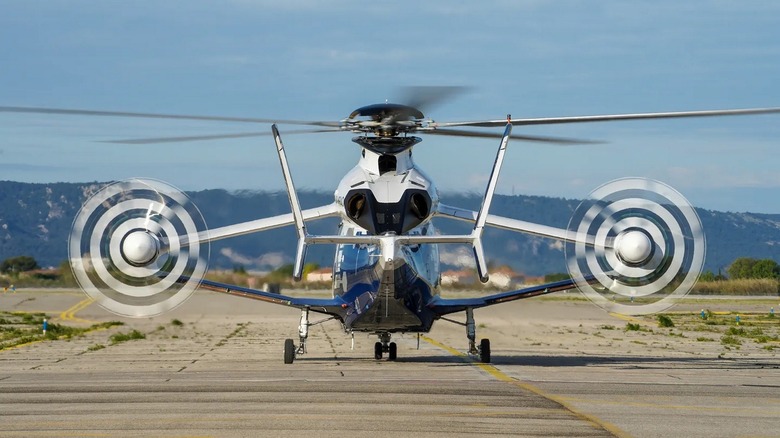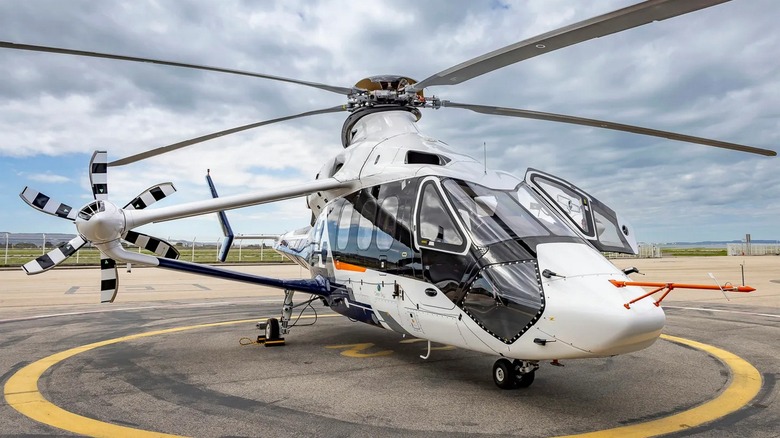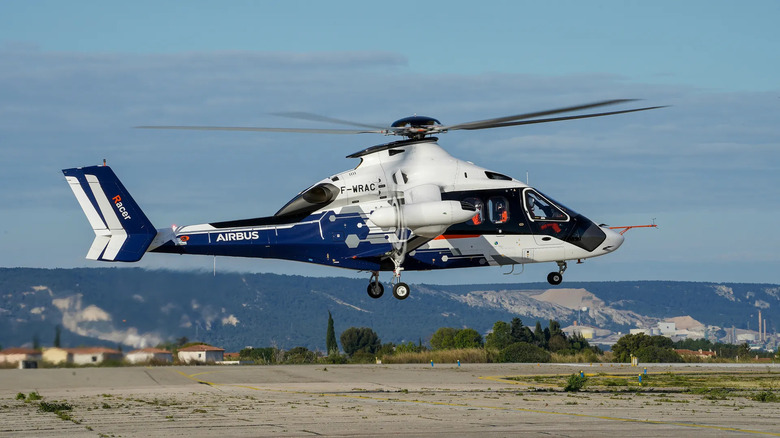Could This Weird Helicopter-Airplane Hybrid Be The Future Of Aviation?
The aviation industry is changing fast. From increasing scrutiny of the carbon footprint numbers to the rise of eVTOL projects, like CityAirbus NextGen and the Lilium Jet, the pace of innovation has never been more feverish. Enter Airbus Helicopters, a French company that aims to redefine what a small-format vehicle can do when helicopter and airplane engineering come together. The result is Racer, a rotorcraft that performed it first flight in April 2024 and was publicly showcased on May 15, in France, according to Reuters.
At first glance, the Racer looks like a regular helicopter, but what sets it apart are the two wing-mounted forward-facing propellors. The Racer is a one-off demonstrator that has been in development for over half a decade as part of the European Research Clean Sky 2 project, but multiple countries are already looking at its potential for critical rescue and emergency aid missions.
Thanks to its unique engineering, the Racer can fly at a top speed of 400 kilometers per hour, nearly double the speed of an average modern helicopter. The company claims that the Racer aims to strike a balance between cost-efficiency, speed, and performance with its half-helicopter, half-airplane design. Moreover, the hybrid-electrical system at the heart of Racer aims to offer a 20% reduction in fuel consumption and carbon dioxide emissions while also cutting down on operational noise.
The best of hybrid engineering
"The aim of the Racer is not to go as fast as possible, but to offer enhanced operational capabilities at the right price for missions where speed can really be an asset," notes project head Julien Guitton. Speed is the key asset here, as Airbus envisions deployment of the Racer for emergency medical situations to save lives, search and rescue operations, and general public missions. A major benefit of the Racer is that it needs far fewer bases and comes fitted with retractable landing gear.
The special power management system, which was developed in collaboration with the French Civil Aviation Authority, cuts off power from one of the two Aneto-1X engines while cruising, and when needed, it can be started "almost instantaneously." The fixed-wing design also contributes to fuel efficiency as it bears roughly 40% lift load off the main rotor during take-off. "By adjusting the distribution of power between the rotors, we can alter the position of the aircraft and carry out totally unprecedented low-noise approaches," says Guitton.
Another key benefit is that compared to solutions like the tilt-rotor technology which employs sophisticated swiveling side-mounted rotors, the Racer would require lower maintenance – thanks to a hybrid metallic-composite airframe – while delivering a long operational cycle. Airbus says noise reduction is another victory for the Racer as it leaves behind a smaller acoustic footprint.
It could be a gamechanger
Airbus has fitted a bunch of innovative elements to the Racer, which includes an asymmetric cross-section profile that helps the hover performance without affecting cruise flight, an aerodynamic box wing profile, an optional alternating engine system, and a next-gen current generator. The main rotor at the top has also been designed to reduce drag and wake motion, while the patented double-wing system on each side improves chassis stiffness, offers better weight balance, enhances aerodynamic performance, and ensures a higher degree of passenger safety.
At the end of each composite wing is a lateral rotor fitted in a pusher configuration. "The dynamic configuration enables 15% less fuel burn per nautical mile at 180 kts compared to a conventional helicopter at 130 kts," says the company. The major objective here is making the best of the "golden hour" that is critical for medical emergencies and rescue operations.
Another promising aspect is the lower fuel consumption and emissions. According to The Guardian, private jets belonging to billionaires and celebrities pumped 415,518 tonnes of carbon dioxide into the atmosphere, in less than two years. As per Carbon Market Watch, Taylor Swift's private jet alone amounted to carbon emissions worth 8,300 tonnes in 2022. Transport and Environment notes that private planes are approximately 50 times more polluting than trains, and dump up to 14 times more toxic chemicals into the air per person than commercial planes. Solutions like the Racer could offer crucial respite for short-distance journeys in the near future.


